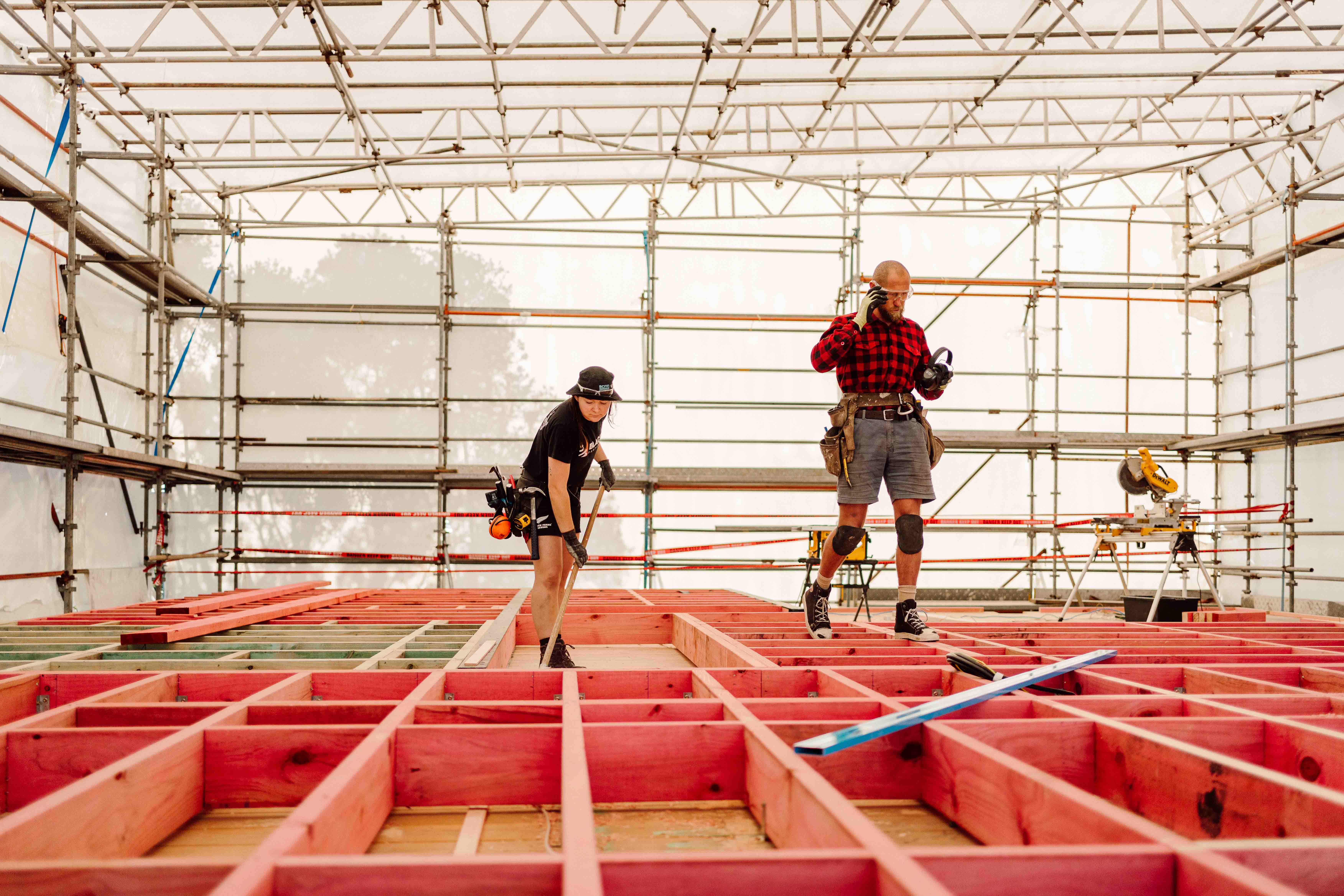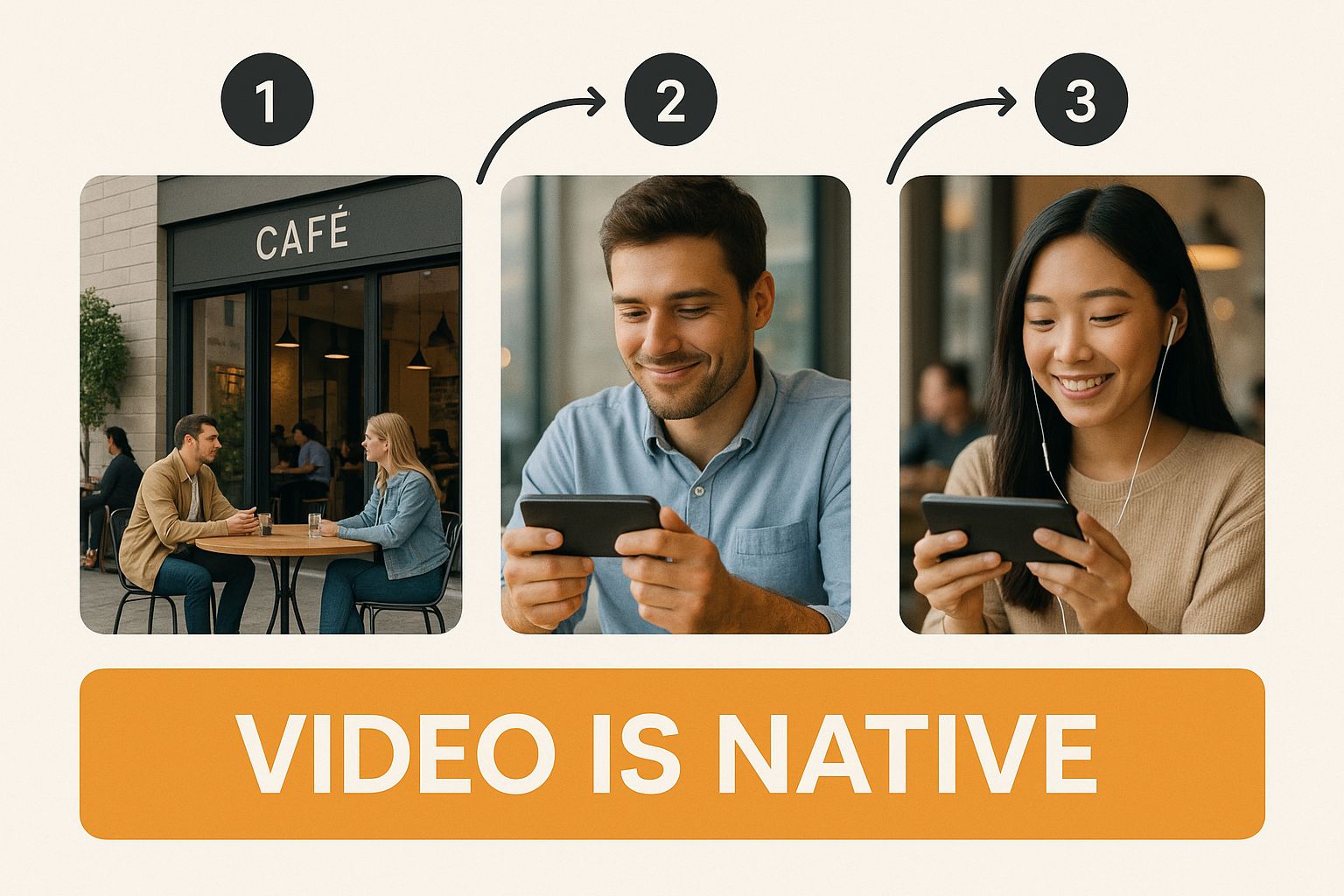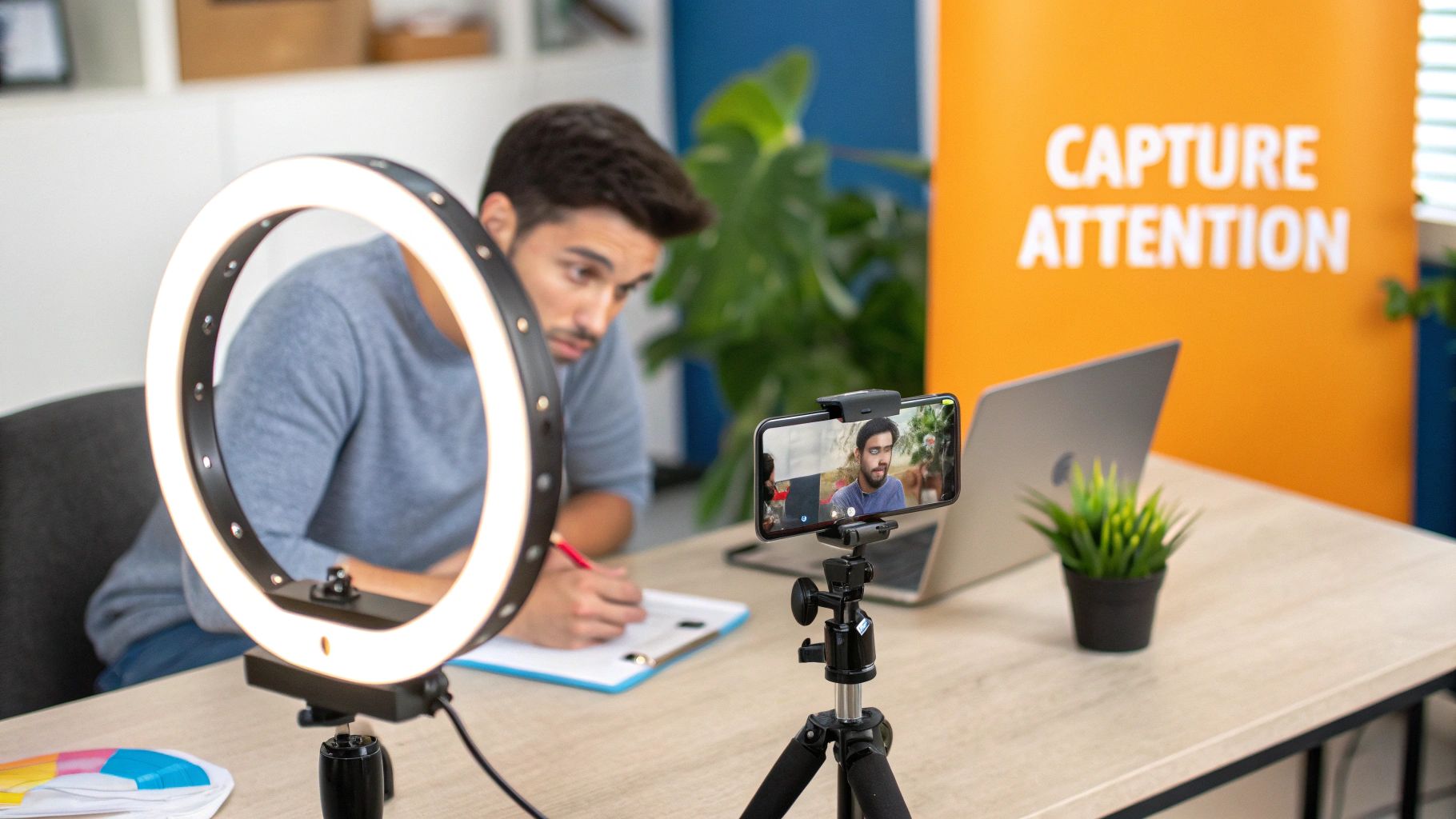


Let's be honest, social video production isn't just another marketing "nice-to-have" anymore. It's now a fundamental tool for any Kiwi business wanting to connect with customers where they actually spend their time. This is all about creating video content specifically for platforms like Instagram, Facebook, and TikTok—videos designed to be engaging and shareable, not just another traditional ad.
For builders and tradespeople, this is your chance to turn everyday project updates and client testimonials into compelling, scroll-stopping stories.
Here in New Zealand, the massive shift towards video isn't just a fleeting trend; it's the new normal. Think of your social media feed as a bustling digital neighbourhood, and video is the local language everyone's speaking. A static image or a plain text post? That's like being a tourist fumbling with a phrasebook. A well-crafted video, on the other hand, speaks fluently, connecting with people instantly and authentically.
We see a huge gap in the market for Kiwi businesses, especially in the building and trades sectors. You might have an amazing website, but if your social media is still stuck in the "old language" of static posts, you’re getting lost in the noise of today's lightning-fast feeds. Getting good at social video production is how you close that gap and start getting noticed.
Video gives you the unique ability to show, not just tell. Sure, a builder can post a photo of a finished deck, and that's great. But a short video showing the entire transformation from start to finish, capped off with the happy client’s genuine reaction? That tells a much richer, more persuasive story.
This kind of visual storytelling builds trust and an emotional connection that a text-based post simply can't match.
This infographic paints a perfect picture of how video has become the default way we engage online, even in relaxed settings like grabbing a coffee.

The message here is simple: your potential clients are already watching videos every single day. It's the most direct way to get their attention.
The numbers for New Zealand don't lie. In early 2025, Instagram alone reached 2.50 million users in the country—that’s 47.8% of the entire population. Even with this huge audience, particularly among younger Kiwis, many of the 75% of local businesses on Facebook are still relying on static content. They're missing a massive opportunity to engage people with the dynamic, exciting formats they actually prefer.
This is exactly where an expert team can give you a competitive edge. You can learn more about our story and how we help builders connect with this exact audience.
By not investing in social video, you are essentially choosing to be silent in the busiest room. Your competitors who embrace video are having conversations with your future clients, building relationships before you've even had a chance to introduce yourself.
Great social video doesn’t just happen by hitting the record button and hoping for the best. It’s a structured process, a bit like building a house. You wouldn't start pouring a foundation without a detailed blueprint, right? The same logic applies here.
This entire workflow can be broken down into three clear, manageable stages: pre-production, production, and post-production. Each stage has its own distinct role in taking a rough idea and turning it into a polished video that actually gets results.
This is where all the thinking happens. Pre-production is the planning, the strategy, the blueprint for your entire video project. Before you even think about picking up a camera, you need to know exactly what you're building.
For a Christchurch builder, this could mean scripting a quick video on choosing the right cladding. A cafe owner in Wellington might be storyboarding a 'day in the life' Reel to show off their vibe. This is easily the most important stage because it locks in your video’s purpose.
Key activities include:
Get this stage right, and the rest of the process becomes so much smoother. It saves a world of headaches down the line.
Production is go-time. This is the actual filming stage where you capture all your raw visual and audio materials.
Think of your footage and audio as your building materials—the quality directly impacts the final structure. Whether you're using a top-of-the-line camera or just your smartphone, the fundamentals don't change. A plumber filming a client testimonial needs clean audio and steady footage just as much as a large construction firm shooting a multi-million dollar project showcase.
The focus here is simple: capture high-quality raw material that tells your story well. If you want a deeper look at what the pros focus on during this phase, it’s worth checking out dedicated social media video production services to see how the experts handle it.
Post-production is where the real magic happens. You take all the raw materials gathered during production and assemble them into the final, polished product. This means editing clips together, cleaning up the audio, adding text or graphics, and formatting the video perfectly for each social media platform.
This is the stage that turns raw footage into a story people actually want to watch. Good editing can make a simple video feel incredibly professional, while bad editing can ruin even the best-shot footage. It's all about pacing, sound, and visual polish.
For a lot of NZ businesses, juggling this entire process can feel like a full-time job in itself. Understanding these stages is the first step, but it's the consistent execution that really drives results.
Exploring professional social video production can give you the expertise you need to turn your on-site work into a powerful marketing tool, ensuring every video you put out builds your brand and brings in the right clients.

Creating a brilliant video is one thing, but getting it in front of the right Kiwi audience is a whole different ball game. All your hard work in production needs a clear destination, and let's be honest, not all social media platforms are created equal. Where you post is a strategic call that directly shapes who sees your work and how they interact with it.
Think about it. The platform you'd use to share a detailed walkthrough of a new build is completely different from where you'd post a quick, satisfying clip of a perfect mitre cut. One is designed for deep engagement; the other is for a quick hit of entertainment. Nailing these differences is the key to making your video investment actually pay off.
The easiest way to think about this is to picture each platform as a different venue.
YouTube is like a public library or a technical college. It’s a place people go with a specific goal in mind – they’re searching for answers, tutorials, or detailed information. This makes it the perfect home for your in-depth project showcases, heartfelt client testimonials, and handy how-to guides.
On the other hand, Instagram and TikTok are more like a bustling city square. They're fast-paced, entertaining, and built for accidental discovery. This is where short, punchy, and visually slick videos win. It’s your chance to stop the scroll with a dramatic before-and-after Reel or a fun, on-trend video that shows off your team's personality.
If you really want to get into the nitty-gritty, it’s worth comparing YouTube Shorts, TikTok, and Reels to see how their features stack up.
The New Zealand market has some clear favourites when it comes to video. While platforms like TikTok and Instagram are brilliant for grabbing quick bursts of attention, YouTube remains the absolute giant for intentional viewing.
In fact, YouTube's potential advertising reach in New Zealand is an incredible 88.7% of adults—the sixth-highest rate in the world.
This puts a massive audience right at your fingertips, one that dwarfs the global average of 39%. Yet, only about 15% of local businesses are actively advertising on the platform. It's a huge missed opportunity to connect with clients right where they're already looking for solutions.
For a local Kiwi business, this isn't about being everywhere. It's about being on the right platforms, where your ideal clients are actively looking for the expertise you provide. Your video efforts should be focused, not scattered.
To help guide your choice, here’s a quick breakdown of where to start.
Choosing the right channel comes down to knowing your audience and your goals. This table gives a simple overview of the top platforms in New Zealand and how they can work for a building or trade business.
By aligning your video style with what people expect to see on each platform, your content will feel native and natural. This is what leads to much higher engagement and, ultimately, better leads for your business.

In the blink-and-you'll-miss-it world of social media, just having a video isn’t enough. You need to create something that slams the brakes on the endless scroll and gets people to actually look up from their phones.
The line between a video that gets ignored and one that drives genuine leads often comes down to just a few key ingredients. Think of it like a blueprint. Just like any good build, your video needs a solid foundation and a structure people want to look at. Without these core elements, even your most impressive project showcase will just blend into the noise.
Nailing these components is what social video production is all about.
You’ve got about three seconds. That’s it. That’s your window to convince someone to keep watching.
Your video’s opening needs to be magnetic. It could be a dramatic before-and-after, a question that makes them think, or a surprising visual that stops them in their tracks. For a builder, this might be the moment a wall comes crashing down or a stunning drone shot flying over a newly finished roof. The goal is simple: create instant curiosity.
Facts and figures are fine, but stories are what truly sell. At the end of the day, people connect with other people, not faceless businesses. Your videos need to tell a story that forges an emotional link with your audience.
Showcase the passion your team has for their craft, the look of relief on a client’s face when they see the finished job, or the clever problem-solving that happens behind the scenes. This kind of authenticity builds trust far more effectively than any polished sales pitch ever could. It’s about showing the human side of your trade.
A video with muddled, unclear audio is often seen as unprofessional and untrustworthy. People will forgive slightly shaky camera work, but they will almost never forgive sound they can't understand.
You don’t need a Hollywood budget, but clean visuals and crisp, clear audio are completely non-negotiable.
Use a tripod, or even just lean your phone against something, to get a stable shot. Try filming near a window for great natural light – it makes everything look more professional without any extra cost. Most importantly, grab a simple lapel microphone. Poor audio is the fastest way to make someone click away, making it the single most critical technical detail to get right.
Every single video needs to have a point. What do you want the person watching to do next?
Always end your video with a clear, direct call-to-action (CTA). This could be asking them to "Visit our website for a closer look," "Flick us a message for a free quote," or simply "Follow us for more project updates." Without a CTA, you’re leaving potential leads hanging. Guide them to the next step.
You can check out how we apply these principles to create impactful stories by exploring some of our recent client projects.
Putting together a sharp-looking video is only half the battle. The real win comes from understanding how it’s actually performing and what it’s doing for your bottom line. To figure this out, you need to look beyond the vanity metrics—things like likes and follower counts. They might give you a nice ego boost, but they don’t tell you if your videos are actually bringing in paying clients.
Real success is measured by how your content changes what people do. Are they watching right to the end? Are they hitting the link in your bio after seeing you showcase a finished project? These are the questions that uncover your return on investment and prove your video isn’t just an expense—it’s a powerful asset for your business.
To get a proper read on your video’s performance, you need to hone in on the numbers that tie back to business growth. Platforms like Instagram, Facebook, and YouTube have built-in analytics that tell you exactly what’s landing and what’s not.
Here are the numbers you should be keeping a close eye on:
Knowing the numbers is one thing, but using them is what separates the pros from the amateurs. The data tells a story about what your audience wants to see. If a quick, behind-the-scenes video on your phone gets double the watch time of a highly polished project showcase, that’s a huge clue. It tells you your audience is crying out for that raw, authentic content.
This data-first approach is only becoming more critical as more money flows into this space. Social media video ad spend in New Zealand is on track to hit US$459.46 million in 2025. That boom is happening because a whopping 89% of businesses now see video as a non-negotiable marketing tool. By keeping a close watch on your performance, you make sure every dollar you invest is pulling its weight. You can dig into more of these NZ social media advertising trends on Statista.com.
Think of your video analytics as a client feedback form, delivered in real-time. Every view, click, and drop-off is a piece of information telling you what to do more of and what to ditch. Listen to it, and your content will only get better.
Jumping into social video can feel like a massive undertaking, especially when you’re already flat-out running a business. It’s totally normal to have questions swirling around about the cost, the gear, and where on earth you'll find the time.
Let's tackle the most common hurdles we see Kiwi business owners run into and give you some straightforward, practical answers. The idea here is to clear those roadblocks and show you that creating effective social video production is well within your reach.
This is always the first question, and the answer is surprisingly flexible. Honestly, the cost can range from pretty much nothing right up to thousands of dollars—it all comes down to how you want to play it.
You can genuinely get started with a zero-dollar budget. The powerful camera you already have in your pocket—your smartphone—is more than enough. Pair that with a free editing app like CapCut, and you can start creating authentic, effective content that connects with your audience without spending a cent.
If you decide you want something more polished and bring in a professional videographer, you might budget between $1,000 to $3,000+ for a day's shoot. The best strategy? Start small. Set a budget that feels comfortable, see the results, and then scale up. Your first and most important investment should be a simple lapel microphone to make sure your audio is crystal clear.
People are surprisingly forgiving of video that isn't perfectly shot, but they have almost zero patience for bad audio. Clear sound is a non-negotiable that instantly makes your content feel more professional and trustworthy.
Forget the idea that you need a van full of expensive camera gear. A modern smartphone has more than enough power to get the job done and look great.
If you want to dramatically lift your production value, you only need three simple, affordable bits of kit. These will make a bigger difference to your final videos than a brand-new camera ever could.
The secret isn't finding more hours in the day—it's about being smarter with the time you already have. The most efficient way to do this is batching.
Instead of trying to create videos one by one whenever you find a spare moment, block out one chunk of time each month. Use that single session to plan, shoot, and even edit a bunch of videos at once. This 'batching' workflow is incredibly productive and ensures you always have a steady stream of content ready to go.
You can also get clever with repurposing. That longer project showcase you filmed for YouTube? It can easily be chopped up into several short, punchy videos for Instagram Reels or TikTok. The key is to start small. Just aim for one or two videos a week to build a routine that’s sustainable, not stressful.
Don't overthink it. The videos that work best are the ones that provide real value and build trust with your local audience.
You want to focus on content that shows off your expertise and puts a human face to your brand. These formats don't need big budgets to be incredibly effective.
Ready to turn your on-site work into a powerful marketing tool that wins you better jobs? Onsite Media is your specialist content partner. We create high-impact video and photo content that builds trust and brings in quality enquiries. Book a no-obligation chat with us today.

